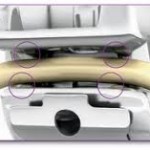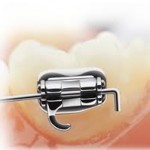Secure archwire engagement and low friction as a combination
Other bracket types—most notably Begg brackets—have achieved low friction by virtue of an extremely loose fit between a round archwire and a very narrow bracket, but this is at the cost of making full control of tooth position correspondingly more difficult. Some brackets with an edgewise slot have incorporated shoulders to distance the elastomeric from the archwire and, thus, reduce friction, but this type of design also produces reduced friction at the expense of reduced control. A deformable elastomeric ring cannot provide and sustain sufficient force to maintain the archwire fully in the slot without actively pressing on the archwire to an extent that increases friction.
Comparison with a molar tube is helpful in this context, since such an attachment is in essence a self-ligating bracket with the clip permanently closed. Once a convertible molar tube is converted to a bracket by removal of the slot cap or straps, an elastomeric or even a wire ligature can prove very ineffective at preventing rotation of the tooth if it is moved along the wire or used as a source of inter-maxillary traction. These ligation methods simultaneously increase friction as they attempt to retain full archwire engagement. With tie-wing brackets an improvement in one respect is usually at the cost of deterioration in the other. The combination of very low friction and very secure full archwire engagement in an edgewise-type slot is currently only possible with self-ligating brackets (or with molar tubes!) and is likely to be the most beneficial feature of such brackets. This combination enables a tooth to slide along an archwire with lower and more predictable net forces, and yet under complete control, with almost none of the undesirable rotation of the tooth resulting from a deformable mode of ligation, such as an elastomeric.
Anchorage consequences of low friction and secure full archwire engagement
This combination of properties can conserve anchorage for three reasons:
With low friction, the net tooth-moving forces are more predictably low and the reciprocal forces correspondingly smaller. Although the evidence shows that the relationship between force level and tooth movement is complex, it does support the idea that lower forces per unit root area lead to more anchorage.
Lower net forces deflect archwires less and, therefore, facilitate release of binding forces between wire and bracket, enhancing sliding of brackets along a wire.
Individual teeth—for example, canines—can be retracted separately along an archwire and thus potentially reduce the overall anchorage demands by reduction of the root area of teeth to be moved at any one time, but with none of the potential disadvantages of other methods of separate canine retraction, e.g. loss of rotational control. Following such separate canine retraction, the low friction of self-ligating brackets then permits the sensible use of sliding mechanics to retract incisors, even though there will now be a minimum of three brackets distal to the remaining space through which archwire sliding must occur.
Alignment of severely irregular teeth
The other situation in which the combination of low friction and secure full engagement is particularly useful, is in the alignment of very irregular teeth and the resolution of severe rotations, where the capacity of the wire to slide through the brackets of the rotated and adjacent teeth significantly facilitates alignment. This relationship between friction and derotation has been described and quantified by Koenig and Burstone, and the potential adverse forces shown to be very large. Low friction, therefore, permits rapid alignment and more certain space closure, whilst the secure bracket engagement permits full engagement with severely displaced teeth and full control, whilst sliding teeth along an archwire. Modern, low modulus wires substantially enhance our ability to harness these benefits.
Less chairside assistance and faster ligation/archwire removal
The original motive when developing the earlier self-ligating brackets was to speed the process of ligation. For example a paper by Maijer and Smith demonstrated a four-fold reduction in ligation time with Speed brackets compared to wire ligation of conventional brackets. Shivapuja and Berger have shown similar results but also that the speed advantages compared to elastomeric ligation are less dramatic (approximately 1 minute per set of archwires). Voudouris has also reported a fourfold reduction in archwire removal/ligation time with prototype Interactwin brackets which lead to the commercially available In-Ovation brackets. A study by Harradine found statistically significant, but clinically very modest savings in ligation/re-ligation time with Damon SL—an average of 24 seconds per archwire removal and replacement. It should, however, be remembered that archwire ‘ligation’ using self-ligating brackets does not require a chairside assistant to speed the process, since self-ligating brackets require no passing of elastomeric or wire ligatures to the operator during ligation. Although the evidence suggests that this is the least significant advantage of self-ligation, it is still perhaps worthwhile.
Passive self ligating brackets
 Research indicates that optimum orthodontic forces should be just high enough to stimulate tooth movement without cutting off the vascular supply to the periodontal ligament. The passive self-ligating brackets of the Damon System are designed to allow the clinician to use these optimum low forces throughout all phases of treatment. This is only possible with a completely passive system. The Damon System facilitates healthy tooth movement with complete control.
Research indicates that optimum orthodontic forces should be just high enough to stimulate tooth movement without cutting off the vascular supply to the periodontal ligament. The passive self-ligating brackets of the Damon System are designed to allow the clinician to use these optimum low forces throughout all phases of treatment. This is only possible with a completely passive system. The Damon System facilitates healthy tooth movement with complete control.
Less Friction Means Low Forces
From the aesthetics of Damon 3 to the strength of Damon 3MX, Damon brackets produce significantly less friction than conventional or active self-ligating appliances. By greatly reducing the amount of friction in the Damon bracket system, low-force archwires can work to peak expression, thereby stimulating a more biologically compatible tooth movement. Low forces throughout treatment also mean greater patient comfort.
No Elastic Ligatures
The Damon System’s passive self-ligating brackets eliminate the use of elastomeric ligatures. That’s because conventional ties such as O-rings and stainless steel ligatures make using optimal forces impossible due to friction and binding. Elastomeric O-rings will lose half their elasticity within days of initial tie-in, thus compromising tooth control.
O-rings are extremely plaque retentive and greatly increase the number of microorganisms attached to appliances during treatment, increasing the incidence of decalcification during treatment. Even fluoride-releasing elastomerics lose almost 90% of their fluoride protection in two weeks.
Optimal Sliding Mechanics
 Sliding mechanics is usually considered only in terms of space closure, but sliding mechanics comes into play in many other aspects of tooth movement such as engaging high cuspids, correcting rotations and leveling and aligning.
Sliding mechanics is usually considered only in terms of space closure, but sliding mechanics comes into play in many other aspects of tooth movement such as engaging high cuspids, correcting rotations and leveling and aligning.
When moving a high cuspid into position using traditional twin appliances, there is a tendency for the lateral incisor and first bicuspid to move superiorly while the cuspid moves into position.
With a passive self-ligating system like the Damon System, moving a cuspid into place does not adversely affect the adjacent teeth.
Similarities and differences from conventional braces
One of the most significant differences from conventional dental braces is the absence of elastic ligature (bands or ties). Self-ligating braces typically are smaller and more aesthetic since a metal door is required to hold wires in place (this prevents “invisible” or clear options of these braces, with the exception of 3M Unitek who have devised a hybrid bracket called the “Smartclip”). They also tend to stand off the teeth further toward the lips and cheeks. The ties on this type of brace are used to hold the archwire in place. The self-ligating braces uses a slide mechanism to hold the archwire, thus reducing the amount of pressure exerted on the teeth. However, there are many similarities to typical braces, such as the fitting on such appliances; self-ligating braces are glued onto the teeth and are not removable until treatment is complete. Regular cleaning is also essential for effective treatment and desirable results. The consumption of too much sugar (in food, and especially drinks) and poor dental hygiene can result in decalcification which is permanent scarring on the teeth.
The SPEED System
The SPEED Appliance is a miniaturized self-ligating appliance which offers overlapping benefits to both patients and clinicians. Patients enjoy the benefits of improved hygiene, aesthetics and comfort while clinicians benefit from time savings in self-ligation and precision in tooth movement due to the action of SPEED’s Super Elastic Spring Clip.
